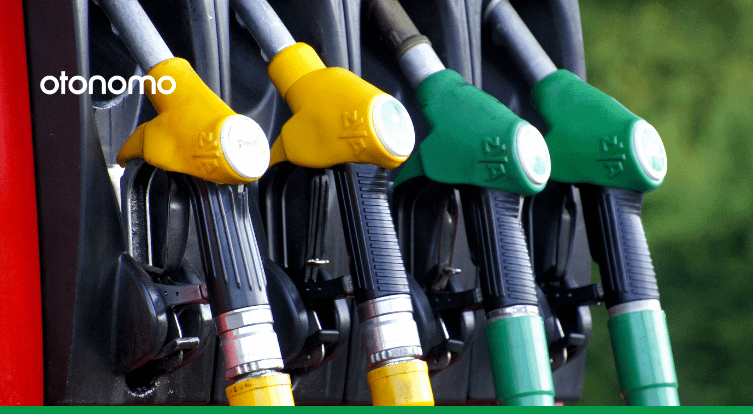The most expensive mile you’ll ever drive is the one you didn’t need to.
Fuel spend is one of the fleet’s largest expenses and a great fuel management system is one of the fleet’s biggest opportunities for savings.
A study conducted by the American Transportation Research Institute (ATRI) found that fuel costs made up 24% of the total average marginal costs within the trucking industry in 2018 —more than insurance premiums, tolls, repairs, maintenance, tires, permits, and licensing expenses combined. That’s a large chunk of the overall operations spend, so anything fleets can do to reduce these costs canresult in higher profit margins. Low fuel efficiency is also costly for the environment, especially when it comes to medium and heavy-duty vehicles, which account for 20% of transportation-related carbon emissions.
Fleet management companies that oversee fleet performance and maintenance, use vehicle telematics to gain real-time visibility into fleet operations for better control of fuel consumption, which in turn, reduces overall costs. Connected vehicle data enables real-time visibility into many aspects of a fleet’s operations that can ultimately have an impact on how much money is being spent on fuel.
5 Ways Connected Vehicle Data Can Impact Fuel Savings
| TYPE | HOW IT SAVES FUEL | |
|---|---|---|
| 1 | Route Optimization | Saving fuel with pre-planning and shortcuts |
| 2 | Preventative Maintenance | Good maintenance practices cut fuels expenses and increase vehicle life |
| 3 | Minimize Excess Idling | Stop wasting time, fuel, vehicle life span and profits |
| 4 | Speed Limiting | Start limiting speeding and excess breaking to increase fuel economy and vehicle life |
| 5 | Tire Monitoring | Accurate tire pressure can increase fuel economy, tire life and safety |
Route Optimization – A Fuel Saving Shortcut
Proper planning can potentially lead to big savings. From optimizing driver routes to analyzing the best places to refuel your vehicles, the goal is to take the shortest and least expensive route possible to save time on the road and money in the fuel budget.
Avoiding traffic jams as much as possible should be factored in as well – a vehicle can use a quarter of a gallon of gas for every 15 minutes it idles!
Finding the efficient routes for today’s transportation vehicles is not a trivial task. It entails finding the shortest routes for multiple drivers that make hundreds of individual stops, while factoring in order priorities, driver schedules, and many other constraints. In the era of online maps and navigation apps, it is easier for drivers to take the fastest and most direct route to their destinations.
However, a quick route is only half the battle. An efficient trip will have as many errands, meetings and business stops incorporated into it as possible, to avoid traveling to the same location multiple times.
As you add new customers or change your stops, routes need to be reviewed to improve efficiency. By looking into route performance, you can identify trips that are frequently ahead of or behind schedule and update your routes to save time and fuel.
How can connected vehicle data help?
Connected vehicle data can play an important role in effectively managing journeys and choosing the best routes. The ability to track and monitor vehicle location, fuel level and idle state can help fleet management companies to stay on top of fleet performance in real-time, avoid congestion where possible, prevent unnecessary journey overlaps and reduce fueling expenses.
Preventive Vehicle Maintenance – A Fuel Economy Highway
Overlooked maintenance checks can have a big impact on fleet fuel economy as a vehicle’s performance can be negatively impacted by its maintenance status. Anything that makes the engine work harder wastes gas and increases fuel expense.
Here are few examples of how good vehicle maintenance can cut down on fuel costs:
- Timely oil replacement – The older and dirtier oil gets, the harder an engine must work to circulate it, and the more wear on the engine.
- Proper grade of oil (preferably the manufacturer recommendation) – Incorrect oil weight, such as 10W-30 instead of 5W-30, can lower fuel efficiency by as much as 1-1.5%. This is especially critical in freezing temperatures – an engine sitting overnight must work harder at circulating the heavier weight oil before it gets warm.
- On-time filters change – Air and fuel flow can be negatively impacted when filters become clogged
A well-maintained engine is typically at its peak operational efficiency, which will directly lead to fuel usage efficiency. Keeping a routine preventative vehicle maintenance that includes regular oil changes, fluid checks, wheel alignments, cooling system flush/fill, and transmission fluid changes, can yield some serious savings.
How can connected vehicle data help?
Connected vehicle data can help keep up with preventative maintenance schedules to increase fuel savings.
- Automated odometer readings, service inspection times and residual distance notifications can be used to optimize maintenance scheduling and the availability of vehicles.
- Warnings, such as brake lining wear, brake fluid, tire pressure and even windows washer fluid warning enable fleet management companies to track important safety and maintenance features, alert drivers and quickly schedule required actions and repairs.
- Fuel level warnings can facilitate better understanding of fuel consumption trends to optimize routes
- Vehicle warnings can be utilized to take action in order to keep fleet vehicles in tip-top shape.
Minimized Engine Idling – The Road to a Fuel-Friendly Fleet
For many fleets, vehicle idling burns through profits. Excessive motor vehicle idling increases fuel consumption, which not only intensifies engine wear and shortens vehicle life, but also has a negative impact on the environment.
The amount of fuel a vehicle consumes while idling varies depending on factors, such as weight, engine size, and the type of fuel it takes. Additionally, vehicle idling does more damage to the engine than starting and stopping, since an engine running at low speed (idling) causes twice the wear compared to driving at regular speeds. The American Trucking Association estimates that idling can increase vehicle maintenance costs by $2,000 per year in addition to shortening the engine lifespan.
How can connected vehicle data help?
Tracking vehicles’ speed through connected vehicle data can be used to gain insights into idling behavior and utilized to educate drivers, improve routes and more.
Speed Limiting – Driving Expenses Downhill
The driver has the biggest impact on fleet fuel economy. Depending on the type of vehicle, poor driving habits, such as speeding and hard braking, account for 5% and 33% fuel waste. Guiding driver behavior is one of the most effective ways in managing fuel expenses.
Reducing speed is an easy route to fuel costs savings, since driving vehicles at higher speeds consumes more fuel. Although vehicles differ, there’s a steep drop in fuel economy at around 60 mph (96 km/h) or so. Speeding can also result in sudden stops, exacerbating the waste and further increase in fuel costs. One quick solution is setting the cruise control to help drivers maintain a steady, consistent speed.
Aggressive driving can crush fleet fuel efficiency, pose safety risks and increase wear and tear. It can and should be changed.
How can connected vehicle data help?
Ongoing vehicle speed can facilitate driving behavior monitoring and leveraged to create personal driving behavior profiles. Bad driving behavior can be then tackled with adequate programs.
Tire Monitoring – The Fast Lane
Tires may not be the biggest fuel saver, but they matter. Monitoring tire pressure can help manage fuel expenditure across the fleet, as properly inflated tires maintain fuel efficiency, increase tire lifespan and support drivers’ safety. Under-inflated tires increase rolling resistance, which is the pressure that a rolling tire puts on the road, and resistance forces the engine to use more fuel.
The U.S. Department of Energy estimates that 4% to 11% (15%–33% for heavy trucks) of U.S. fuel consumption is related to rolling resistance. A 5% reduction in rolling resistance may improve fuel economy for light- and heavy-duty vehicles in ~1.5%, so if a fleet spends $500,000 annually on fuel, a 1.5% reduction means saving $7,500 per year.
Proper and even tire inflation and truckload will reduce the flexing, stress and build-up in the tire that lead to wasteful fuel use. Additionally, the amount of energy tires apply while rolling under a full load can greatly affect the fuel consumption.
How can connected vehicle data help?
With connected vehicle data fleets benefit from real-time tire pressure, status and relevant warning notifications that were freshly sampled. Real-time tire pressure data can be used to alert drivers on road and schedule tire replacement to save fuel expenses, eliminate manual inspections, and minimize delays and idle time.
Why wait? Harness embedded vehicle data to power fleet fuel management systems
Leverage a wide variety of high-quality connected vehicle data from multiple makes and models to maximize fuel savings. Otonomo Vehicle Data Platform expedites embedded fleet connectivity through a single integration and one data dictionary. The cleansed and normalized data from multiple OEMs can be effortlessly accessed through a straightforward API. The regulatory compliance is alleviated through one-touch onboarding and defleeting of fleet vehicles.
Test drive our connected fleet data






